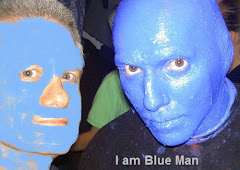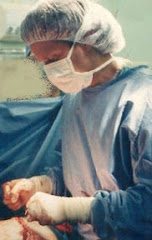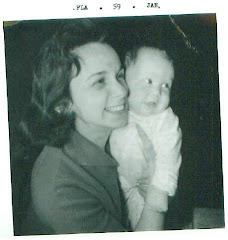 I love this stuff. The space around the spinal cord is filled with fluid so that the cord itself, and nerves exiting and entering the cord from the body, are cushioned and have room to accommodate our movement. When that space is impinged upon by portions of the soft pads between the vertebrae bones, you have a herniated disc, also known as HNP, herniated nucleus pulposus, "slipped" disc, extruded disc or similar. The most impressive case of this appeared in the clinic one afternoon. This is located at the level between the 5th lumbar and the 1st sacral vertebrae at the end of the spine near the buttocks.
I love this stuff. The space around the spinal cord is filled with fluid so that the cord itself, and nerves exiting and entering the cord from the body, are cushioned and have room to accommodate our movement. When that space is impinged upon by portions of the soft pads between the vertebrae bones, you have a herniated disc, also known as HNP, herniated nucleus pulposus, "slipped" disc, extruded disc or similar. The most impressive case of this appeared in the clinic one afternoon. This is located at the level between the 5th lumbar and the 1st sacral vertebrae at the end of the spine near the buttocks.This patient presented with low back pain, and some numbness and tingling in both legs including the inner thigh and buttocks (the place where you sit on a horse saddle...also known as "saddle numbness"). The patient noticed weakness in the legs and complained cold/heat intolerance (noticed in the shower) to both legs.
The family physician that had been following the patient for about 6 weeks ordered an MRI and sent her to be evaluated by an orthopaedic spine surgeon. Faced with the above presentation and the extremely pronounced extruded fragment of central disc into the spinal canal, surgery is not always indicated. However with the pain, weakness and pattern of sensory loss, surgery was indicated and performed. Symptoms cleared up within one month of surgery.
All disc herniation is not so severe. In fact, many persons walk around with herniations in varioius stages and don't even know they have one (or more) until they have an MRI (plain xray of the back can't see the discs since they have no bone in them). They are often asymptomatic. When they produce symptoms, conservative treatment can be very helpful and is work the trial before jumping into surgery. Spontaneous improvement of such symptoms has been known to happen with and without treatment. Conservative treatment might include: bedrest of no longer than 1-2 days, ice for immediate swelling and acute injuries, anti-inflammatory medicines like ibuprofen, warm and moist heating, physical therapy to improve flexability, stability, strength and stamina, muscle relaxers for muscle spasm and aerobic exercise like walking or swimming. Accupuncture and chiropractic have been helpful in some patients, but are not generally considered part of "allopathic" standard care (but that is changing in some areas of the country).
For more chronic pain, injections can also help to improve symptoms. Again, these can "heal" and shrink during this time period and may resolve with time. That is the key in many cases...time. However not everyone will improve at the same rate of time. Other time tested modalities that have shown to be helpful for symptoms: electrical stimulation, massage, hot packs, ultrasound and similar techniques to reduce inflammation, improve circulation and move toward normalized muscle and support structure function.Surgery is literally a last resort when all else fails. Unless symptoms threaten normal function and are in danger of progression or activities of daily living, surgery is not usually the first line of therapy and should be considered carefully. Usually symptoms of nerve compression, weakness (nerve signal to muscles) and tendon reflex changes are more indicative of the need for surgery. Surgery was successfully performed on this patient. No post operative complications occured. A very happy patient; And after back surgery, that is a great result.
All disc herniation is not so severe. In fact, many persons walk around with herniations in varioius stages and don't even know they have one (or more) until they have an MRI (plain xray of the back can't see the discs since they have no bone in them). They are often asymptomatic. When they produce symptoms, conservative treatment can be very helpful and is work the trial before jumping into surgery. Spontaneous improvement of such symptoms has been known to happen with and without treatment. Conservative treatment might include: bedrest of no longer than 1-2 days, ice for immediate swelling and acute injuries, anti-inflammatory medicines like ibuprofen, warm and moist heating, physical therapy to improve flexability, stability, strength and stamina, muscle relaxers for muscle spasm and aerobic exercise like walking or swimming. Accupuncture and chiropractic have been helpful in some patients, but are not generally considered part of "allopathic" standard care (but that is changing in some areas of the country).
For more chronic pain, injections can also help to improve symptoms. Again, these can "heal" and shrink during this time period and may resolve with time. That is the key in many cases...time. However not everyone will improve at the same rate of time. Other time tested modalities that have shown to be helpful for symptoms: electrical stimulation, massage, hot packs, ultrasound and similar techniques to reduce inflammation, improve circulation and move toward normalized muscle and support structure function.Surgery is literally a last resort when all else fails. Unless symptoms threaten normal function and are in danger of progression or activities of daily living, surgery is not usually the first line of therapy and should be considered carefully. Usually symptoms of nerve compression, weakness (nerve signal to muscles) and tendon reflex changes are more indicative of the need for surgery. Surgery was successfully performed on this patient. No post operative complications occured. A very happy patient; And after back surgery, that is a great result.




